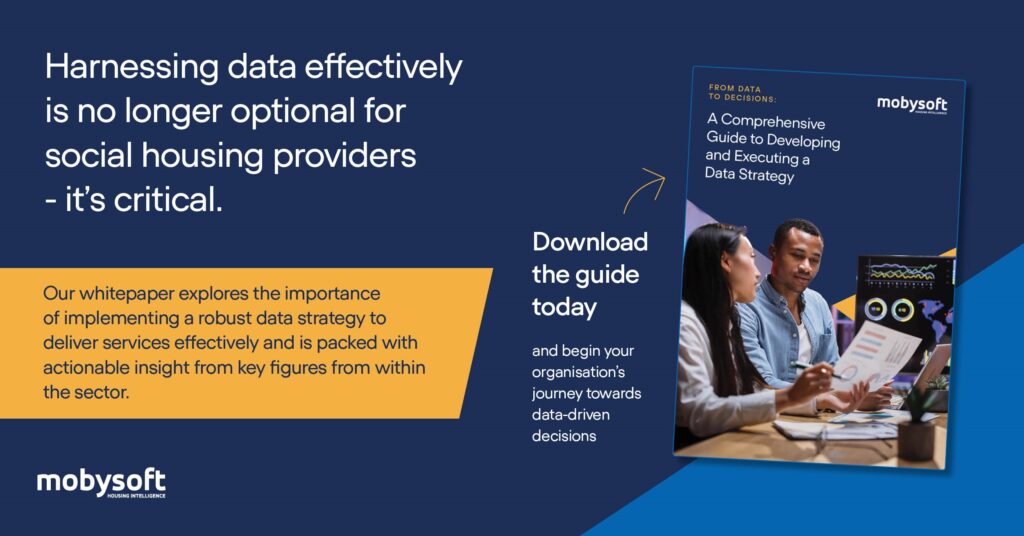How to Build a Winning Data Strategy for Social Housing
Mobysoft’s new report, From Data to Decisions: A Comprehensive Guide to Developing and Executing a Data Strategy, sets out a clear path for organisations looking to take their approach to data to the next level. With regulatory pressures mounting and tenant expectations rising, a robust data strategy is no longer a ‘nice to have’, it’s a ‘must have’ for social housing landlords.
But where do you start? Here are five practical steps to help housing providers take control of their data and unlock its full potential.
1. Know Where You Stand
Before making changes, you need to understand what’s working, and what isn’t. A data maturity assessment is the perfect place to begin. Think of it as a health check for your organisation’s data. Are your systems fragmented? Is your data reliable? Are there gaps in governance?
According to exclusive polling by Mobysoft with 100 senior housing decision-makers, 62% of senior housing staff reported examples of poor data quality in their organisations over the past year. That’s not just inconvenient; it’s a roadblock to progress. By identifying strengths and weaknesses early on, you can focus your efforts where they’ll make the biggest impact.
As Ian Kelly from Plus Dane Housing puts it: “Doing a root cause analysis to see where data is causing a problem is key. This could be because your systems don’t hold the information, or the data isn’t correct, up-to-date, or kept fresh”.

2. Set Clear Goals
A data strategy isn’t just about fixing what’s broken, it’s about potentially revolutionising some of the ways in which the organisation works. So, it’s important to set out clearly what success look like for your organisation. Maybe it’s reducing response times for repairs, improving tenant satisfaction scores, or hitting regulatory targets with confidence.
Whatever your goals, make sure they’re specific and measurable. Clear targets help keep your organisation on track and make progress easy to demonstrate. As Jason Wickens from the Disruptive Innovators Network notes: “Setting clear priorities, a practical plan, and digestible actions is key. Things won’t improve overnight; it’ll take investment and time. Measuring success is crucial because you need to keep people on that journey”.
3. Map Your Path
Big ideas are great, but they need to be paired with a realistic plan. A clear roadmap lays out the steps you’ll take to implement your data strategy, whether that’s introducing governance frameworks, improving data quality, or investing in new technologies such as AI.
This is where leadership becomes essential. Change doesn’t happen by accident, it needs buy-in from the top. Leaders must prioritise data as a strategic asset and allocate the resources necessary to make the roadmap a reality. As Kate Lindley from the Change Network says: “Nothing happens without a push from the top. I think organisations don’t necessarily appreciate the level of governance that’s required around day-to-day data”.
4. Invest in the Right Tools
While shelling out on the latest tools won’t get your organisation to the next level on its own, the right technology can make or break your data strategy. Modern, scalable solutions, such as cloud-based data warehouses enable housing providers to centralise their data and integrate fragmented systems. This creates a strong foundation for advanced analytics and even AI, which 65% of senior housing staff are keen to explore.
But remember; tools are only as good as the data they process. Poor-quality data in means poor-quality results out. That’s why data governance and quality management must come first.

5. Get the Right Team on Board
A data strategy is only as good as the people driving it. That means building a team with the right mix of skills and expertise. For some organisations, this might mean recruiting new talent. For others, it could involve upskilling existing staff.
More than half of senior housing staff polled identified training as key to improving data quality. A well-trained team is one that’s confident in using tools, interpreting data, and turning insights into action. Collaboration is equally important. When IT and operational teams work together, data strategies stop being isolated projects and become integrated parts of the organisation.
Take the First Step
Building a data strategy might feel like a daunting task, but the rewards are worth it and some of them can be felt from day one. From improving efficiency to boosting tenant satisfaction, a strong strategy sets the stage for lasting success. By following the roadmap in Mobysoft’s new paper, housing providers can turn data from a liability into an asset.
The journey starts now. With the right strategy, you can move from reactive problem-solving to proactive service delivery, ensuring better outcomes for tenants and your organisation alike. Download From Data to Decisions – A Comprehensive Guide to Developing and Executing a Data Strategy. today!
